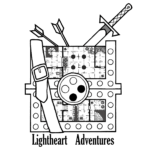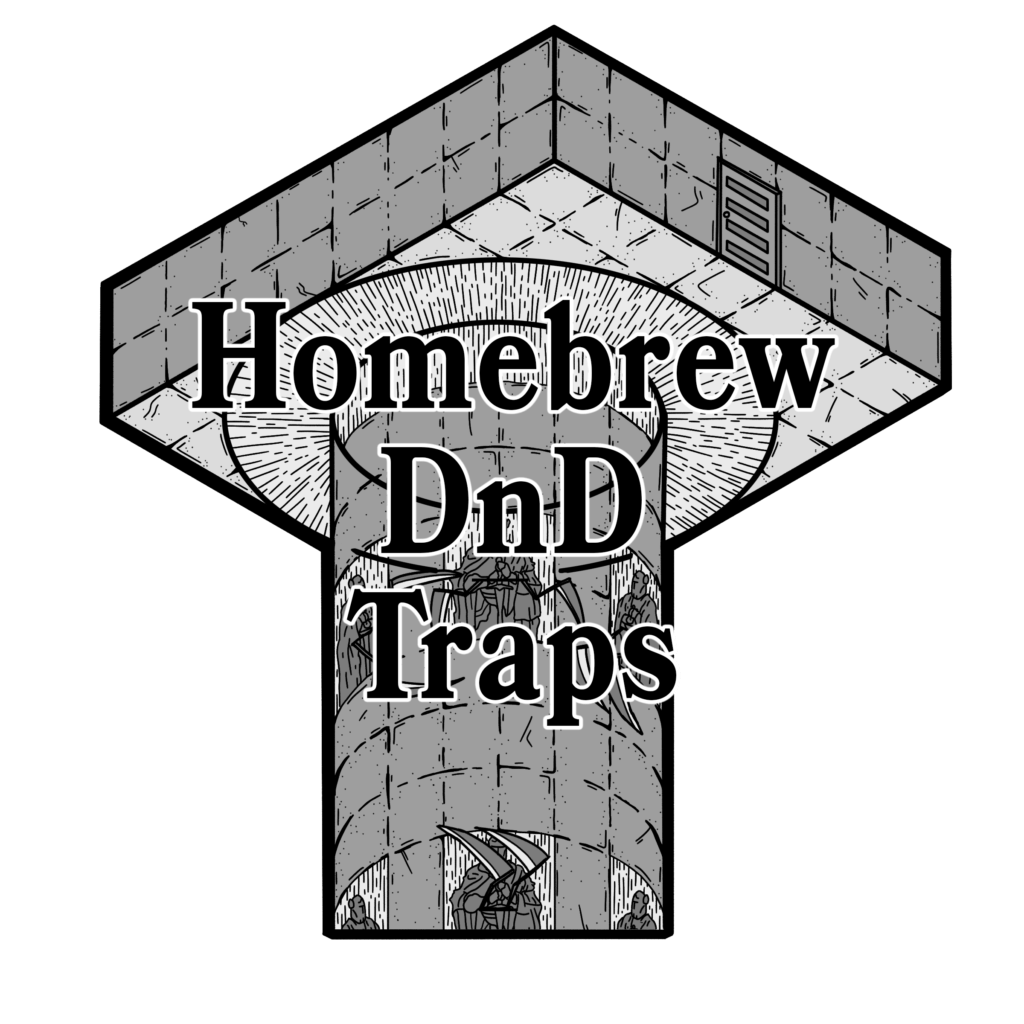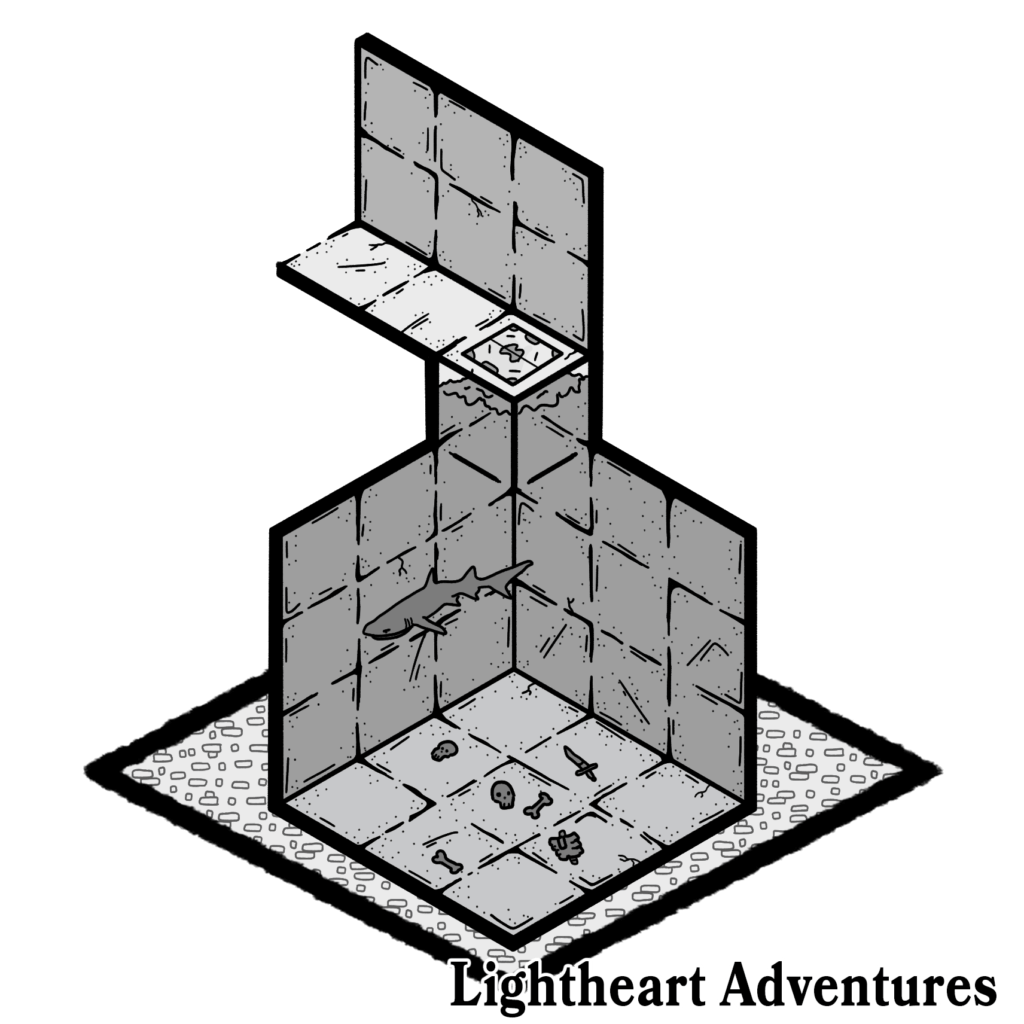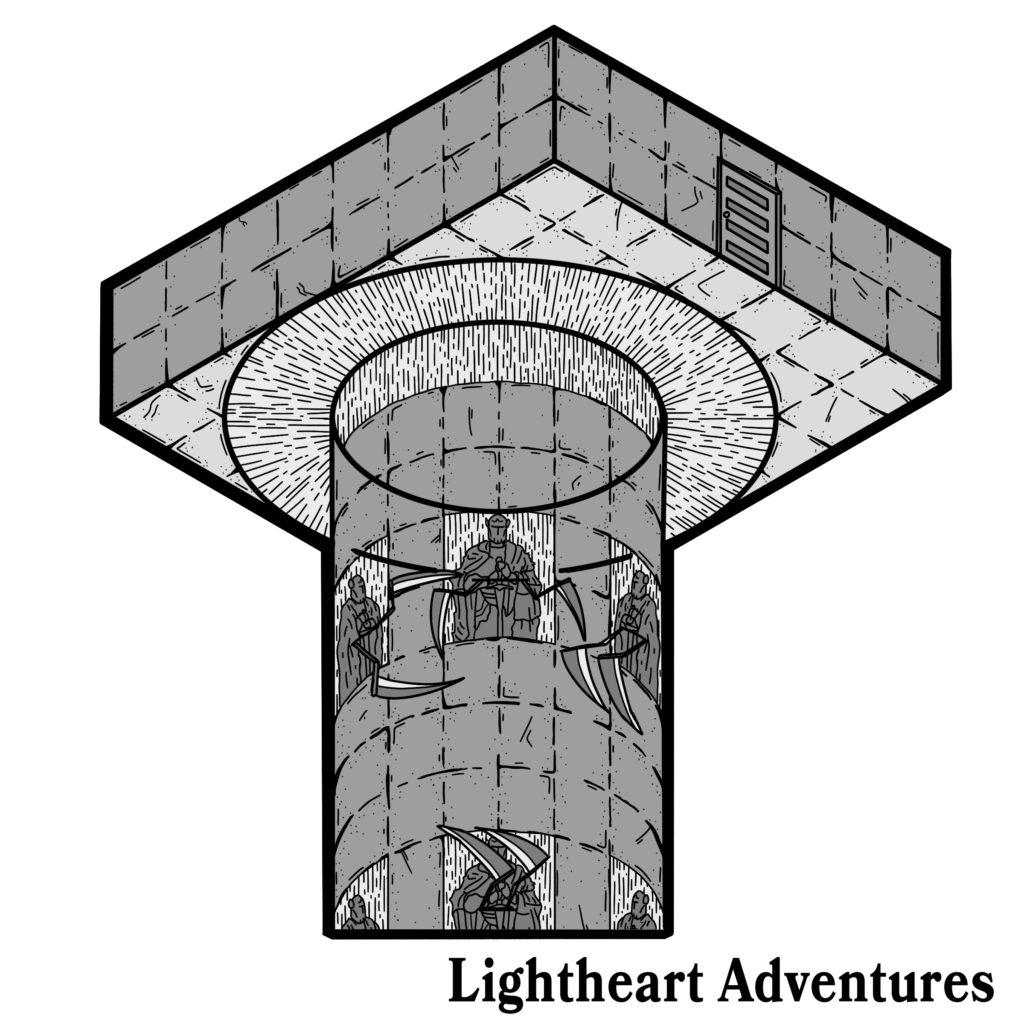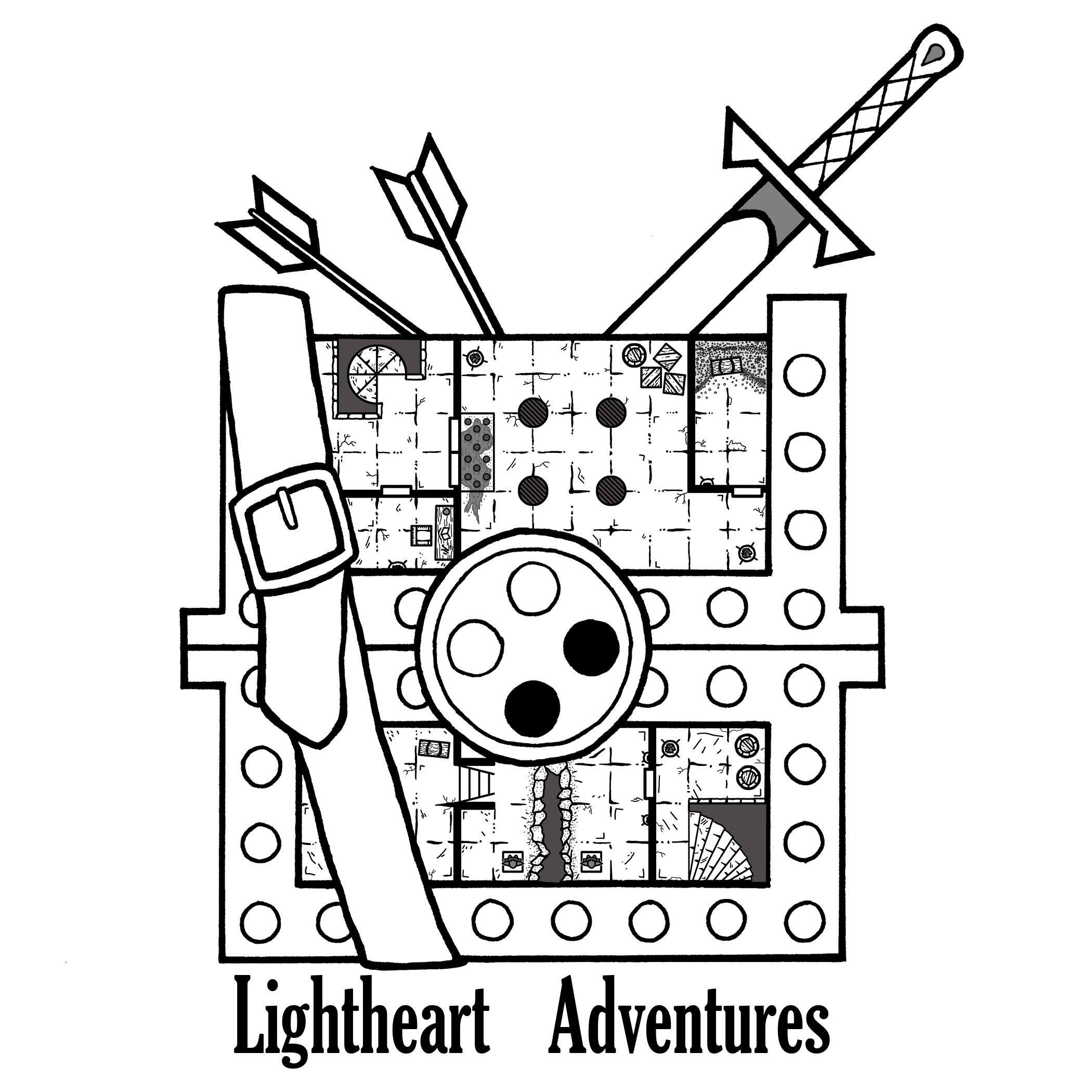Do you ever find yourself wanting to spice things up for your players? Maybe the party Rogue is getting a little too confident, and you want to throw them a little curve ball. Perhaps your party is getting tired of fight scene after fight scene and you want to give them a puzzle or two. I thoroughly enjoy creating my own homebrew D&D traps for my players to stumble upon, and today I’m sharing eight of my favorite creations with you.
With that, I’d like to present the Lightheart Adventures Homebrew D&D Traps: Volume 1 for your reading and adventuring enjoyment!
Simple D&D Traps
Owlbear Jaws
“We’re going to need a bigger trap”
Owlbear Jaws are larger, sturdier cousins to the normal bear traps used by hunters all across the realms. Two sets of steel jaws lie around a pressure plate to snap up and hold onto anything triggering it. Hunters need special permits to obtain these legally, as use on lesser prey is reprehensible.
Simple trap (level 1-5 dangerous threat)
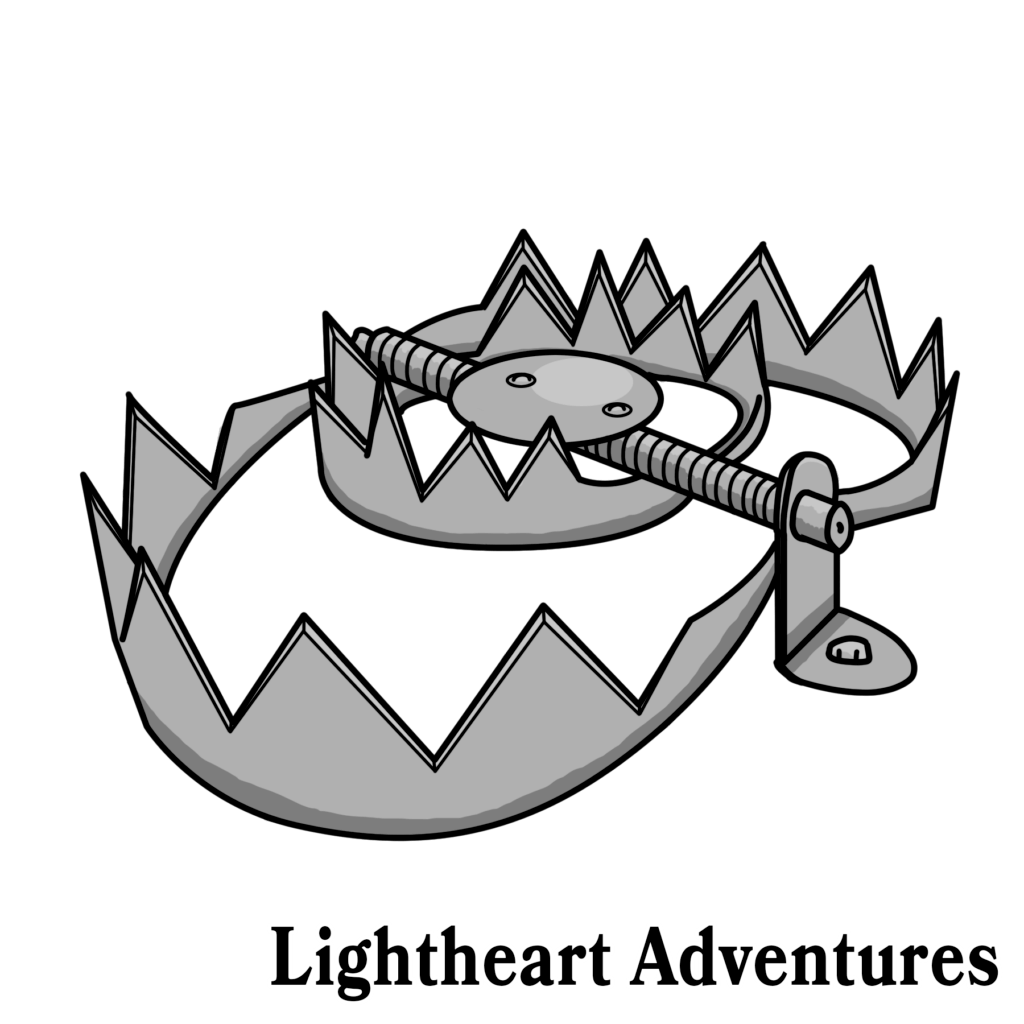
High-res version of image available for download on Patreon
Trigger: A creature that steps on the center plate triggers it.
Effect: The trap makes an attack against the triggering creature. The attack has a +10 attack bonus and deals 15 (3d10) piercing damage on a hit. This attack can’t gain advantage or disadvantage. A creature hit by the trap has its speed reduced to 0. It can’t move until it breaks free of the trap with a successful Strength check (DC 18) made by it or another creature adjacent to the trap.
Countermeasures: A DC 14 Wisdom (Perception) check reveals the trap. A DC 12 Dexterity check made with thieves’ tools disables it.
Sprite Snare
“It catches them easy enough, but damned if I’ll be the one that lets them out of it!”
Evil folk that prey upon tiny fey creatures use this cruel implement. Six small tentacle-like silver rods entwine the base of an iron cage that is hung in the air. These enchanted rods strike out, ensnare any tiny creature that passes nearby, and imprison them within the cage. Minor camouflage illusions allow these snares to blend with their surroundings.
Simple trap (level 0 dangerous threat)
Trigger: Any tiny creature that moves within 5 ft. of the snare triggers it.
Effect: The trap makes an attack against the triggering creature. The attack has a +10 attack bonus and deals 1 (1d4) bludgeoning damage on a hit. This attack can’t gain advantage or disadvantage. A creature hit by the trap is pulled within the iron cage and has its speed reduced to 0. It can’t move until it breaks free of the trap with a successful Strength check (DC 12) made by it or another creature adjacent to the trap. The snare holds up to 8 tiny creatures at a time.
Countermeasures: A DC 15 Wisdom (Perception) check reveals the trap. A DC 10 Dexterity check made with thieves’ tools disables it.
Boring Spike
“Don’t let the name fool ya, lad – you’ll never be bored when one of these things goes off!”
Boring Spikes are tripod-like apparatus that stand up to ten feet tall with a downward-facing harpoon-like spike at its center. An activated trap extends its legs into the earth for stability and locating prey. When activated, the spike fires directly into the earth towards burrowing creatures at high velocity and drags them towards the surface.
Simple trap (level 5-10 dangerous threat)
Trigger: Any creature that moves up to 80 feet directly underneath the trap triggers it.
Effect: The trap makes an attack against the triggering creature. The attack has a +10 attack bonus and deals 20 (4d10) piercing damage on a hit. This attack can’t gain advantage or disadvantage. A creature hit by the trap has its speed reduced to 0. The trap pulls the target 10 ft closer every round that the creature is ensnared. It can’t move until it breaks free of the trap with a successful Strength check (DC 20) made by it or another creature adjacent to the trap.
Countermeasures: A DC 24 Strength (Athletics) check to knock the spike over disables the trap.
Hidden Depths
“It’s bad enough being trapped, but then you worry about what else is in the trap with you…”
The primary use of water cages were for near-surface level aquatic prisons, though some include truly hazardous traps for air breathers. They consist of vertical cells with doors set at ground level with a level of water that rests above the cell doors. Depending on the size of the cells, some dungeon inhabitants keep trained sharks or crocodiles to attack any who fall within.
Simple trap (level 5-10 dangerous threat)
Trigger: Any singular creature that moves directly over the gate triggers it.
Effect: The triggering creature must make a DC 16 Dexterity saving throw. On a successful save, the creature catches on the pit’s edge or instinctively steps back. Otherwise, the creature falls into the watery pit while the cage door snaps back into position and locks. Any creature unable to breathe water will soon suffocate, based on their Constitution values.
Countermeasures: A DC 15 Wisdom (Perception) check reveals the trap. A DC 16 Dexterity check made with thieves’ tools disables it from either above or below.
Brown Mold Bottle
“Whatever you do, don’t drop the damn thing!”
It takes a determined mind to cultivate brown mold. It takes a demented one to turn brown mold into a lethal weapon. Enterprising wizards add a patch of brown mold into a large jar, then seal a smaller jar containing a single bead from a Necklace of Fireballs inside. When both jars break, the fireball bead activates and combines with the heat-seeking mold which causes a violent expansion. The resulting fungal explosion is large enough to decimate small armies. Jars hang within sections of a dungeon that the architect isn’t too worried about needing to clean up afterward.
Simple trap (level 11-16 dangerous threat)
Trigger: Any creature that trips the catch-wire or disturbs the bottle triggers it.
Effect: The triggering creature must make a DC 18 Dexterity saving throw to attempt to catch the falling bottle. Failure to do so causes both the interior and exterior bottles to shatter, causing the mold to expand out up to a 200-foot radius. When a creature moves within 5 feet of the mold for the first time or starts its turn there, it must make a DC 12 Constitution saving throw to defend against the mold’s heat-seeking traits., The creature takes 22 (4d10) cold damage on a failed save, or half as much damage on a successful one.
Countermeasure: A DC 18 Wisdom (Perception) check reveals the trap. A DC 16 Dexterity check made with thieves’ tools disables the mechanics which would cause the jar to shatter. An additional DC 20 Dexterity check using thieves’ tools is required to remove the fireball bead from the jar. Critical failures could cause the bead to ignite.
Silverweave Net
“It may be shiny, but it’ll burn ya!”
Silverweave netting is the invention of a desperate lover, betrothed to a victim of the uncontrollable lycanthrope curse. They wanted to stop their loved one without causing harm, but normal nets and traps did not work. The crafter found a way to entwine normal thread with enchanted silver, sapping the lycanthrope of their strength without hurting them. To this day, bold hunters use Silverweave nets to hunt creatures adverse to silver.
Simple trap (level 1-5)
Trigger: Any creature that trips the catchwire triggers it.
Effect: The triggering creature must make a DC 15 Dexterity saving throw. On a successful save, the creature avoids the net. Otherwise, the creature is restrained within the folds of the net. A creature caught in the net has its speed reduced to 0. Creatures with an aversion to silver (lycanthropes, hags, wraiths, etc.) take full damage from attacks while restrained, and roll with disadvantage on Strength checks.
Countermeasures: A DC 15 Wisdom (Perception) check reveals the trap. A DC 18 Strength (Athletics) check destroys it.
Complex D&D Traps
The Gilded Pit
“Remember, it’s not the fall that kills you – it’s the rows of swinging scythe blades!”
They say the only way to get to the bottom of King Leomal’s tomb is by descending the gilded pit. The pit is 15-foot in diameter, 200 feet deep, and its walls glitter with golden depictions of Leomal’s knights. Leomal’s artificers crafted wicked blades to swing out automatically at anyone not bearing his seal (of which few remain intact), in addition to a magical field that casts feather fall on any attempting to climb or fall down. There are 8 sets of blades , with each set placed every 25 feet. They all must be disarmed individually.
Complex Trap (level 5-10 dangerous threat)
Trigger: Any creature that stands within 5 ft of the precipice of the gilded pit triggers the trap.
Active elements: The gilded pit includes a set of eight scything blades placed at 25 ft. increments down the length of the shaft.
- Scything blades: The blades attack any creature that passes down through the pit, with a +6 to hit on the attack roll, and dealing 11 (2d10) slashing damage on a hit.
Dynamic element: Collapsing sides. The floor within 5 feet of the edge of the pit is mechanically trapped to change into a steep slide, pitching any who stand upon them into the pit. This is triggered if any section of scything blades is disarmed or broken. A DC 15 Dexterity saving throw is required to move quickly enough without falling into the pit.
Constant element: Feather fall field. Four runes inscribed within the wall at the 50-foot mark casts feather fall on any creature that passes through it. The reduced rate of falling grants each section of scything blades an extra attack as a creature falls past.
Countermeasures: Each of the trap’s active elements offers potential countermeasures.
- Scything blades. Characters can smash the blades and damage their components, the blades are disabled if each section is dealt 15 damage. Alternatively, flying or suspended characters may make a DC 16 Dexterity check with thieves’ tools to disable a section.
- Collapsing sides. A DC 20 Wisdom (Perception) check reveals the trap. A DC 15 Dexterity check made with thieves’ tools disables it.
- Feather fall field. The runes can be disabled with four successful DC 14 Intelligence (Arcana) checks to disrupt the runes. A creature must be within 5 feet of a rune to attempt the check. Alternatively, the runes can be disabled with four successful castings of dispel magic (DC 13) targeting the runes.
A hidden switch embedded in the wall at the bottom of the pit deactivates all traps within the pit. A successful DC 22 Wisdom (Perception) allows characters to spot the hidden compartment.
Everburning Sphere
“I don’t have to be faster than the sphere, I just have to be faster than you!”
An everburning ball of fire floats in the middle of a large, bare room. The floor of this room is five feet lower than the other rooms before or after. The only entrances sit directly across from each other – line of sight is blocked by the enlarged sphere.
Complex trap (level 5-10 dangerous threat)
Trigger: Any creature that stands upon the room’s floor triggers the trap.
Initiative: The trap acts on initiative 10.
Dynamic element: Burnout. Each time a creature suffers fire damage from the Everburning sphere, the sphere deals 1d6 less damage to the next creature it rams into, down to a minimum of 1d6. The sphere regains 1d6 for each turn that it does not damage a creature.
Active element: Everburning sphere. The flaming sphere is a 10-foot diameter ball of fire that chases after any creature that steps foot within the room. The sphere moves up to 45 feet towards the nearest creature standing upon the floor. Any creature that ends its turn within 5 feet of the sphere must make a DC 16 Dexterity saving throw. The creature takes 6d6 fire damage on a failed save, or half as much damage on a successful one. If the sphere rams into a creature, that creature must make the saving throw against the sphere’s damage, and the sphere stops moving this turn. The sphere returns to its spot in the center of the room if no creatures remain standing on the floor.
Countermeasures: Two visible runes sustain the sphere and are located at opposite ends of the room (often on the walls perpendicular to the doors). A rune can be disabled with a successful DC 16 Intelligence (Arcana) check. Each check requires an action. The runes cannot be targeted with dispel magic, but the sphere can be temporarily deactivated (DC 15) for a number of turns equal to the level of the spell cast.
Hopefully, you enjoyed these eight homebrew D&D traps! We love hearing from you, so be sure to connect with us on Twitter, Facebook,Instagram, or Discord to tell us which traps you like and if you use any of them in your own games. If you’d like to snag the trap images along with downloadable PDFs of all our Side Quests, downloadable art, and the ability to vote on future blog topics, visit our Patreon.
